FAQ about DataGrip
FAQ about DataGrip
General questions
Is there a DataGrip Community edition?
No, as there is no way to separate DataGrip functionality into free and paid tiers. You can still try DataGrip by using a free 30-day trial or Early Access Program (pre-release) versions as long as they are available.
How to get DataGrip for free or at a discount?
If you want to get a DataGrip license for free or at a discount, check out the offers on the following page: Toolbox Subscription - Special Offers. If you have any questions, contact our sales support.
Free individual licenses are available for students, faculty members, and core contributors to open source projects.Useful links
Free individual licenses for students and faculty members: see who can apply for free licenses and how you can do that.
Free Open Source Licenses: see application terms, license terms, and restrictions.
Is DataGrip available via the JetBrains Toolbox as part of the All Products Pack?
Yes, it is available both as a standalone IDE and as a part of the All Products Pack.
What is the difference between DataGrip and the Database plugin in other IntelliJ IDE products like IDEA, PyCharm, PhpStorm?
It is the same. DataGrip and the Database plugin for IntelliJ IDEA have the same functionality.
What about version control systems?
DataGrip supports Git, SVN, Mercurial, and other version control systems (VCS). This support is not bundled. It means that you need to install corresponding plugins to have VCS in DataGrip.
In the Settings dialog (Ctrl+Alt+S) , select Plugins. Find the plugin in the Marketplace and click Install.Useful links
Plugins: see how to install and delete plugins, work with custom plugin repositories, write your own plugins.
Version control: this section is devoted to different version control systems and describes the VCS functionality that is available in DataGrip.
In addition to databases and SQL, which web technologies does DataGrip support?
In addition to tools for database management, DataGrip supports HTML, XML, Docker, Git, an HTTP client for testing web services, and other technologies.
How to leave feedback or submit a bug?
The Support and assistance topic describes how to leave feedback, report a bug, or submit a feature request.Useful links
Youtrack issues for DataGrip: log in to your JetBrains account and click New issue.
Requests in the JetBrains Support Center: click the Submit a request button that is at the top of the main page.
Twitter: tweet us about your problem. Mention @datagrip in your tweet.
: email our team about your problem. Describe your problem, and attach all available materials that can speed up troubleshooting (code samples, screenshots, logs, animations, videos, and other materials).
Are stored code debugging, administration tools, and NoSQL features planned?
Yes, we are going to add this functionality in future versions. You can share your thoughts with us and add your vote for the NoSQL support in this Youtrack ticket.
What about data visualization, like graphs or pie-charts?
You can visualize your data by plotting various charts.
For more information about data visualization, refer to Visualize data.
How can I help make the product better?
The best way is to share your feedback. Feel free to report bugs and submit feature requests through our issue tracker.Useful links
Support and assistance: this help page lists various sources of information, ways to collect troubleshooting materials, and provide feedback.
Configuring connections
Can I use DataGrip with SQL dialects that are not listed?
Yes, DataGrip can connect to any database that has a JDBC-driver. For example, with the 2019.3 version, you can connect to Firebird, SAP Hana, Athena, Teradata, and BigQuery.
With a JDBC-driver, you can connect to a database, view database objects, and run queries. Also, you will have some generic code completion and syntax highlighting (based on SQL92). Advanced features like enhanced code completion, database-specific syntax highlighting, and better retrieval of database objects (introspection) are not supported.Useful links
Create a connection to a database with a JDBC driver: see how to create a connection with a JDBC driver.
I cannot connect to the database. What should I do?
Try to follow the steps in the Cannot connect to a database topic. If you still experience problems, email our team at . Describe your problem, and attach all available materials that can speed up troubleshooting (screenshots, logs, animations, videos, and other materials).Useful links
Create a data source for connection to a database with a JDBC driver: how to create a data source with a custom JDBC driver.
Cannot connect to MySQL 5.1: how to create a data source for a MySQL 5.1 database and run a test connection.
Create a Microsoft SQL Server data source: how to create a data source for an instance of Microsoft SQL Server database and run a test connection.
Microsoft SQL Server LocalDB: how to create a data source for an SQL Server Express LocalDB database and run a test connection.
Create a PostgreSQL data source for Heroku Postgres without SSL validation: how to create a data source for a PostgreSQL database without SSL validation, and run a test connection.
Create an Apache Cassandra data source with SSL: how to create a data source for an Apache Cassandra database with SSL, and run a test connection.
How should I connect to Microsoft SQL Server?
See the Create a Microsoft SQL Server data source tutorial that shows how to create a data source for an instance of Microsoft SQL Server database and run a test connection.
We explicitly support MS SQL Server 10.50 2008 R2 and later. If you have earlier versions, go to the Options tab in data source settings and select Introspect using JDBC metadata.
MySQL shows NULL instead of '0000-00-00 00:00:00' in datetime field. Why?
Because of the driver option that is set to in the data source settings.
To configure the option, open the Data Sources and Drivers dialog by pressing Ctrl+Alt+Shift+S, select the MySQL data source, and click the Advanced tab. In the options table, search for . To set other options, click the corresponding cell in the Value column and select the value from the drop-down list.
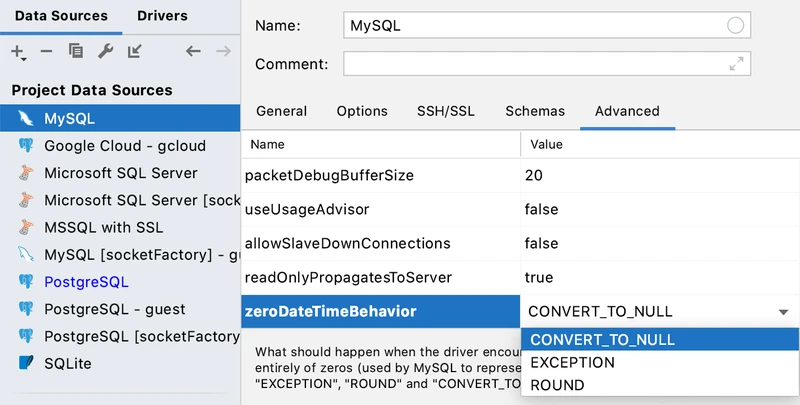
DataGrip shows time in the local time zone, I want it to be shown in UTC, what should I do?
On the Advanced tab in the data source settings, type in the VM options field.
To add to VM options, open the Data Sources and Drivers dialog by pressing Ctrl+Alt+Shift+S, select the MySQL data source, and click the Advanced tab. In the VM options field, type .
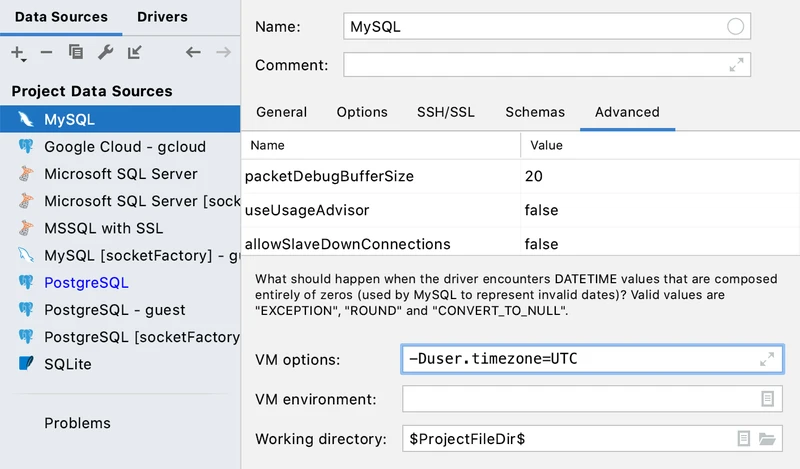
Working with data sources
Can I create a data source from the JDBC URL?
Yes, in the Database Explorer ( View | Tool Windows | Database Explorer), click the Add icon (
) and select Data Source from URL.
/img> In the URL field, paste the JDBC URL. From the Driver list, select the necessary driver for the data source. Enter your credentials and connect to the data source.
img alt="Create a data source from the JDBC URL" src="https://resources.jetbrains.com/help/img/idea/2024.1/db_create_data_source_from_URL.png" class="article__bordered-element" title="Create a data source from the JDBC URL" data-dark-src="https://resources.jetbrains.com/help/img/idea/2024.1/db_create_data_source_from_URL_dark.png" width="460" height="190" /> Can I mark data sources as Production, Staging, or Test? You can mark your data sources with colors. In the Database Explorer ( View | Tool Windows | Database Explorer) , press Ctrl and click data sources that you want to mark. Right-click the selection and navigate to Tools | Set Color. In the Database Color Settings dialog, configure color and appearance settings.
img alt="Mark data sources with colors" src="https://resources.jetbrains.com/help/img/idea/2024.1/db_text_data_viewer_uses_the_color_of_the_data_source.png" class="article__bordered-element" title="Mark data sources with colors" data-dark-src="https://resources.jetbrains.com/help/img/idea/2024.1/db_text_data_viewer_uses_the_color_of_the_data_source_dark.png" width="460" height="492" /> How to put data sources into folders? In the Database Explorer ( View | Tool Windows | Database Explorer) , press F6, and create a new group. To add a data source to the existing group, click the data source, and press F6. Select the group in which you want to add the data source.Useful links Group data sources: see what other actions with data source groups are available. How can I share data sources between DataGrip and other IntelliJ IDE? In the Database Explorer ( View | Tool Windows | Database Explorer) , press Ctrl and click data sources that you want to share. Right-click the selection and navigate to Copy/Paste | Copy Reference. On another workstation, click View | Tool Windows | Database Explorer. In the Database Explorer, click the New icon
img src="https://resources.jetbrains.com/help/img/idea/2024.1/app.expui.general.add.svg" class="inline-icon-" id="i1kcp88_216" title="the New icon" alt="the New icon" width="16" height="16"> and select Import from Clipboard.
Useful links Data sources: see how to create data sources, group data them in directories, import and export their settings. Export and import How do I export data to a format I need? In DataGrip, you export object structures and data separately. It means that you can export a structure of a table and then export data from the table. The full data dump is available only for PostgreSQL and MySQL with the help of mysqldump and pg_dump. The full data dump includes structures of all database objects and data of these objects in a single file. For more information, refer to Create a full data dump for MySQL and PostgreSQL.Useful links Export data: import and export your data to and from various formats with or without special tools like mysqldump, pg_dump, pg_restore, or psql. My Clojure extractors do not work anymore. What should I do? DataGrip does not bundle the Clojure engine. To enable Clojure extractors, install the plugin. In the Settings dialog (Ctrl+Alt+S) , select Plugins. Find the plugin in the Marketplace and click Install.Useful links Plugins: see how to install and delete plugins, work with custom plugin repositories, write your own plugins. What is the difference between Copy and Export to clipboard actions? In contrast to the Export Table to Clipboard action, the Copy Ctrl+C action only copies the selection of rows on the current page. To copy all the rows on the current page, click a cell, press Ctrl+A and then Ctrl+C. To configure a number of rows on a page, refer to Set a number of rows in the result set. Working in the editor Can I work with existing SQL files from my machine? Yes, you need to attach your work directory. In the Files tool window, right-click any area and select Attach Directory to Project. Navigate to the directory that you want to attach and click OK. Also, to attach a directory, navigate to File | Open and select the directory in the file browser. You can find the attached directory in the Files tool window (View | Tool Windows | Files).Useful links User files: see how to attach and detach a directory. How to see the total row count of the result set? In the tab with the result set, click the part of the page counter that displays of N+, where is the number of rows that is set by the Limit page size to option. updates and displays the total row count.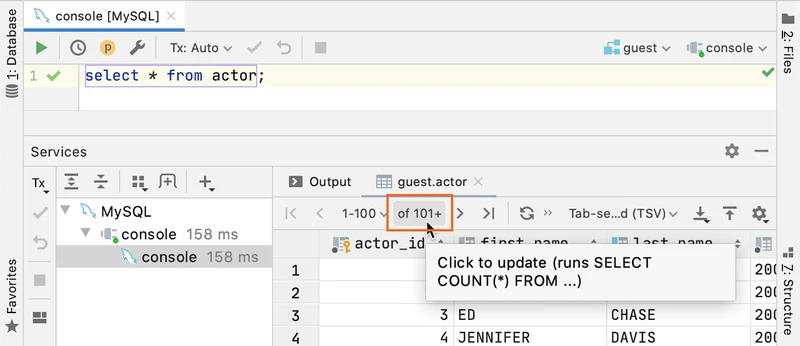 How to generate the SELECT * FROM query from the Database Explorer?
You can double-click the table in the Database Explorer ( View | Tool Windows | Database Explorer). The table opens in the table view. In the table view, you can edit cell values, use paging, sort columns, and do other table operations.
If you want to generate a template for the query, use the live template. Open a query console by pressing F4, type , select the template from the context menu, and press Enter.Useful links
Tables: see what operations you can perform with tables, rows, columns, and cells.
Live templates: a help section about live templates.
Can I generate a diagram for database objects?
Yes, you can create a diagram for a data source, a schema, or a table.
In the Database Explorer ( View | Tool Windows | Database Explorer) , right-click a database object and select Diagrams | Show Visualization.Useful links
Database diagrams: see how to generate diagrams, execution and query plans.
How to set an active data source for code autocompletion?
For the file that is not connected to a data source: from the list of dialects, select a dialect. From the >data source< list, select a connection session of this data source. When the file is associated with a data source, select a schema or construct a search path in which you want to work.
How to generate the SELECT * FROM query from the Database Explorer?
You can double-click the table in the Database Explorer ( View | Tool Windows | Database Explorer). The table opens in the table view. In the table view, you can edit cell values, use paging, sort columns, and do other table operations.
If you want to generate a template for the query, use the live template. Open a query console by pressing F4, type , select the template from the context menu, and press Enter.Useful links
Tables: see what operations you can perform with tables, rows, columns, and cells.
Live templates: a help section about live templates.
Can I generate a diagram for database objects?
Yes, you can create a diagram for a data source, a schema, or a table.
In the Database Explorer ( View | Tool Windows | Database Explorer) , right-click a database object and select Diagrams | Show Visualization.Useful links
Database diagrams: see how to generate diagrams, execution and query plans.
How to set an active data source for code autocompletion?
For the file that is not connected to a data source: from the list of dialects, select a dialect. From the >data source< list, select a connection session of this data source. When the file is associated with a data source, select a schema or construct a search path in which you want to work. For the file that is connected to a data source: select a schema or construct a search path in which you want to work.
For the file that is connected to a data source: select a schema or construct a search path in which you want to work.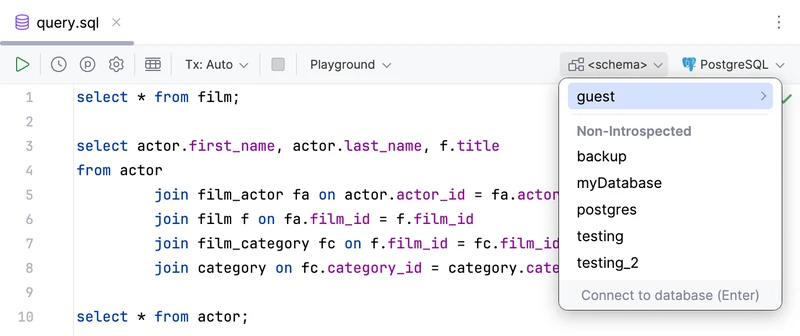 When you have configured settings, coding assistance becomes available for the selected dialect, schema or search path.
For more information about attaching data sources to SQL files, refer to Data source attachment.
When you have configured settings, coding assistance becomes available for the selected dialect, schema or search path.
For more information about attaching data sources to SQL files, refer to Data source attachment.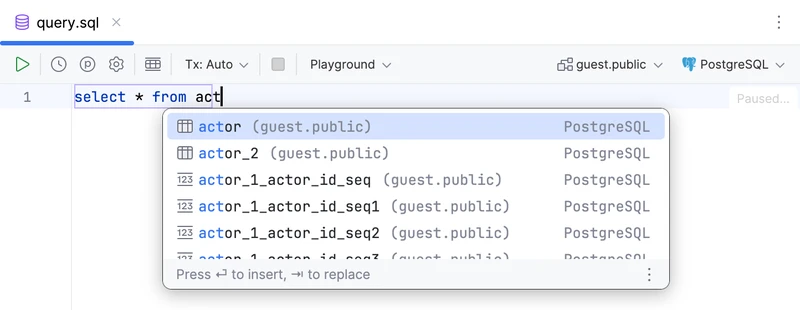 Useful links
Query console reference: see where to select schemas and sessions.Last modified: 09 April 2024Import SQL dump filesSupport and assistance
Useful links
Query console reference: see where to select schemas and sessions.Last modified: 09 April 2024Import SQL dump filesSupport and assistance
